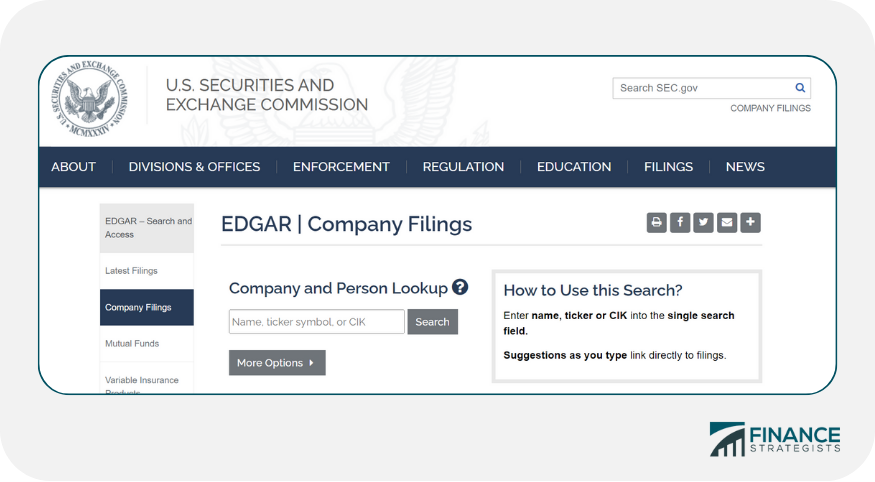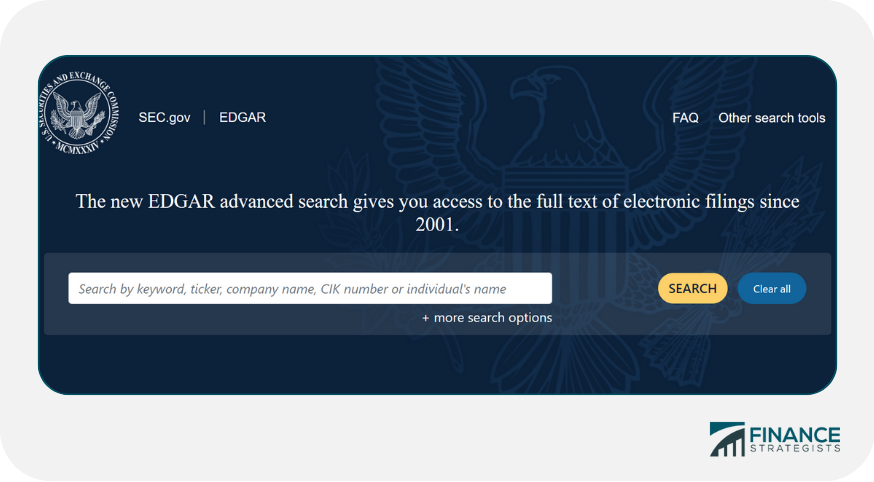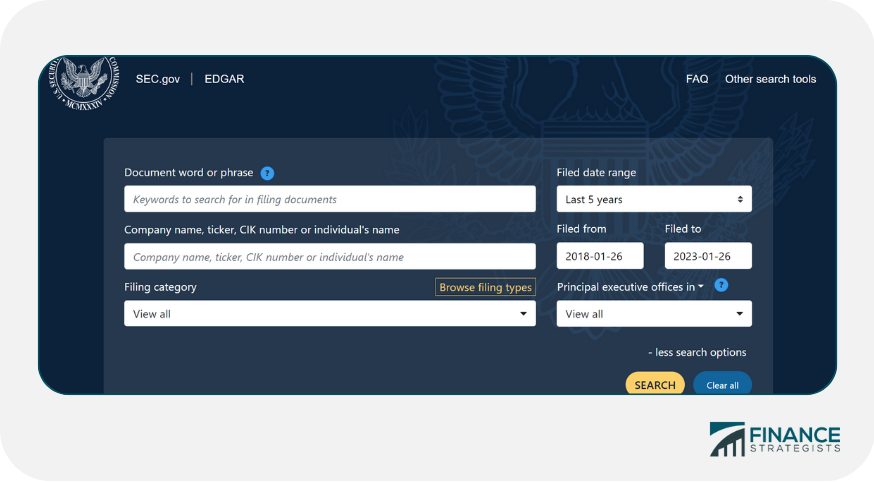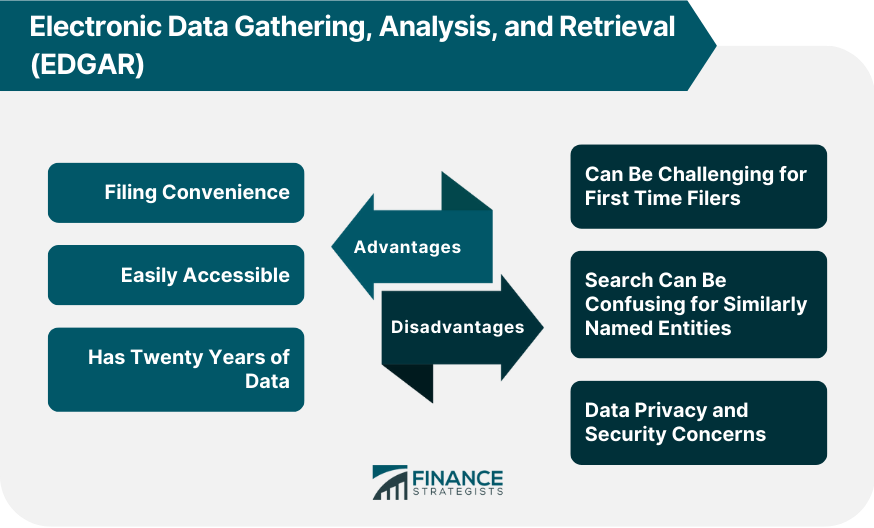The EDGAR system is an automated database maintained by the U.S. Securities and Exchange Commission (SEC) to facilitate the electronic filing of securities disclosure documents. Publicly traded corporations, mutual funds, exchange-traded funds, and other financial entities must submit periodic reports that update investors on their activities. These documents include annual and quarterly financial statements, prospectuses, and other corporate disclosures. EDGAR enables companies to quickly and accurately file these documents with the SEC electronically. It also allows investors, analysts, and the general public easy and free access to such corporate information. EDGAR's purpose is twofold: first, it provides a central repository for companies to make available documents required by law; second, it enables investors easy access to corporate disclosure documents to assess investment decisions more accurately. It helps ensure market transparency so that all investors have equal access to accurate information about public companies when making their financial decisions. In the early 1980s, the SEC started developing an electronic system to replace an outdated and expensive paper-based system that required companies to manually submit documents, often resulting in delays of several days or weeks for filing reports with the Commission. The initial EDGAR system was launched in 1992, allowing electronic filing on a voluntary basis. The SEC began to require the use of EDGAR in phases starting in 1993. By 1996, all publicly traded companies were filing documentary requirements electronically. The EDGAR System provides a searchable database of documents filed with the SEC. Investors can search for company filings through the EDGAR website. This tool is best used if you know the specific company to review. There are three different options to do the standard search for filings. First, you can input the company name in the single search field and click the search button. As a second option, you may also enter the company's ticker symbol, the letter combination used to identify security on most U.S. stock exchanges, such as the NYSE and NASDAQ. A third option is to use the Central Index Key (CIK) number assigned by the EDGAR's computer system to all individuals and corporations who file disclosures with the SEC. Additionally, you may narrow your search by including a company's state or country of origin. When you locate the company, you can search based on the date or type of filing. A full-text search has also been added to the list of tools on the EDGAR website. It lets you look for filings through keywords or phrases from more than 20 years of data within EDGAR. Simply input a text and click “Search.” It also accepts names, ticker symbols, or CIK numbers. To set more detailed search parameters, click “+more search options.” It allows you to narrow your inquiry based on filing type, date, and location. From the results, click on a title to view the whole document. EDGAR also allows specialized searches like filings from the previous week, mutual fund prospectuses, proxy voting records, and variable insurance products. Lastly, a separate boolean search tool provides access to the EDGAR archives, with information dating as far back as 1994. You can view all the documents as HTML or in plain text format. Documents filed with the SEC through EDGAR are available for public viewing, including the following: Form 10-K is an annual report that all publicly traded companies must file in the U.S. This document contains information about a company's business operations, financial performance, and other essential details. It also includes risk factors that investors may consider when making decisions about buying stocks in the company. Form 10-Q contains unaudited financial and other data that investors use to understand a given company's condition and past performance. It includes condensed versions of the company's income statement, balance sheet, and cash flow statement. It also includes information about any material events or changes in operations that have occurred during the quarter and management's evaluation of its business. It must be filed in connection with any solicitation of proxies from shareholders facilitated by an issuer. Specifically, it informs investors of all pertinent facts regarding an upcoming shareholders’ meeting so they can make an informed decision regarding their vote. The statement includes information about the company's board of directors, executive compensation, and any proposals that will be voted on at the upcoming meeting. Here is an example of a filled-out DEF 14A form. It must be filed when a company plans to sell securities to the public. The registration statement includes detailed financial and other information about the offering, which potential investors use to assess its risk. It also includes information about how much money the issuer intends to raise from the offering and how it intends to use those funds. The registration statement is filed using Form S-1. It must be filed with the SEC whenever a publicly traded company experiences significant events that could impact its stock price, including changes in management, mergers and acquisitions, bankruptcy proceedings, or other material events about its operations. The Form 8-K contains factual and narrative information about the event and its potential impact on the company. It provides investors with up-to-date information that may be critical for their investment decisions. Forms 3 and 4 disclose information about a company's officers and directors. Form 3 must be filed when an officer or director is first appointed, while Form 4 must be filed whenever an insider purchase or sale of the company's securities is made. The forms include information about the transactions and any potential conflicts that may arise from them. SEC Form 5 is used when insiders fail to report a change in ownership of a company’s shares. It includes transactions related to equity compensation plans, like stock grants, options exercises, and restricted share purchases. The form also provides information about any transaction that may affect the company's financial condition. The EDGAR system offers a single database for all public filings. It is convenient for publicly traded companies to report financial information and for investors to access such information for their financial decisions. It has more than twenty years of data, which makes it easier for companies and investors to keep track of filings. EDGAR data can help them better understand the current state of a company's finances and allow them to make more informed decisions. Nonetheless, sometimes it can be challenging to understand the requirements, especially for companies that are filing for the first time. The search function can also be confusing for investors, particularly with similarly named entities. It may be better to view pertinent information from a corporation's website. Data privacy and security concerns regarding reports stored within EDGAR are also possible. The EDGAR system is an online database for corporate filings with the SEC. It allows companies to quickly and easily comply with SEC regulations regarding the disclosure of financial and other information. It makes such documents as annual and quarterly reports, proxy and regulatory statements, and other mandatory forms easily accessible to investors and the public, creating more transparency in the market. Along with advice from a professional financial advisor, the SEC EDGAR system is invaluable in helping you make sound investment decisions to achieve your financial goals.What Is Electronic Data Gathering, Analysis and Retrieval (EDGAR)?
Purpose of EDGAR
How to Use EDGAR
Simple Search

Full-Text Search


Boolean Search
Accessible Documents Through EDGAR
Annual Reports (Form 10-K)
Quarterly Reports (Form 10-Q)
Proxy Statements
Registration Statements
Form 8-K
Forms 3 and 4
Form 5
Advantages & Disadvantages of EDGAR

Final Thoughts
Electronic Data Gathering, Analysis and Retrieval (EDGAR) FAQs
EDGAR (Electronic Data Gathering, Analysis, and Retrieval) is a system created by the U.S. Securities and Exchange Commission (SEC). It is an automated electronic filing system to publicly disclose corporate information, such as annual reports and other financial documents. EDGAR also facilitates public access to this information.
It can be used to analyze companies' reporting and financial performance. By accessing company filings via the EDGAR online database, investors and researchers can gain insight into a company's operations and finances.
EDGAR contains information about a company's operations, financial performance, management team, risk factors, and more. EDGAR also holds other data types, such as insider transactions and ownership positions.
You can access EDGAR data through the SEC's online database, which is free and open to the public. You can search for specific documents or filter results by company name, filing type, or date.
Most publicly traded companies in the U.S. must file with EDGAR to comply with SEC regulations. Companies must report certain information regularly, such as financial statements and other corporate disclosures. Private companies may also use the EDGAR system for voluntary disclosure purposes.
True Tamplin is a published author, public speaker, CEO of UpDigital, and founder of Finance Strategists.
True is a Certified Educator in Personal Finance (CEPF®), author of The Handy Financial Ratios Guide, a member of the Society for Advancing Business Editing and Writing, contributes to his financial education site, Finance Strategists, and has spoken to various financial communities such as the CFA Institute, as well as university students like his Alma mater, Biola University, where he received a bachelor of science in business and data analytics.
To learn more about True, visit his personal website or view his author profiles on Amazon, Nasdaq and Forbes.











